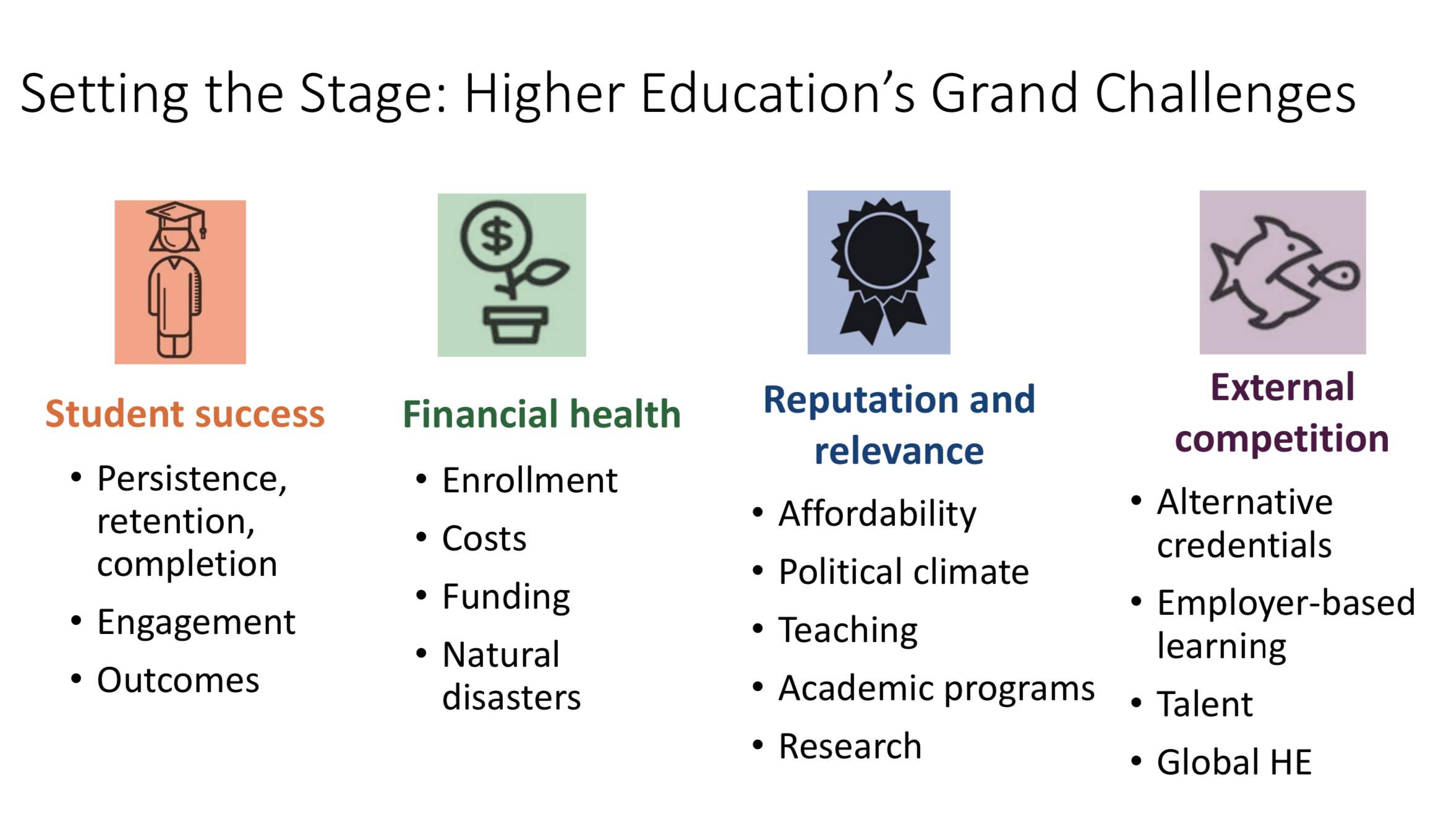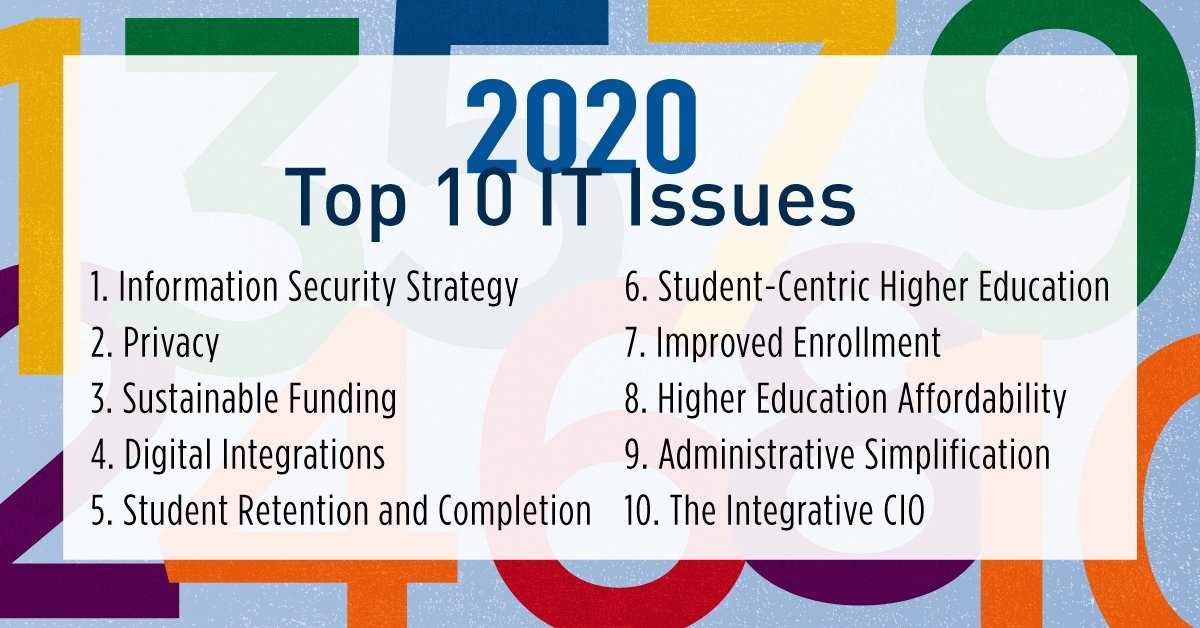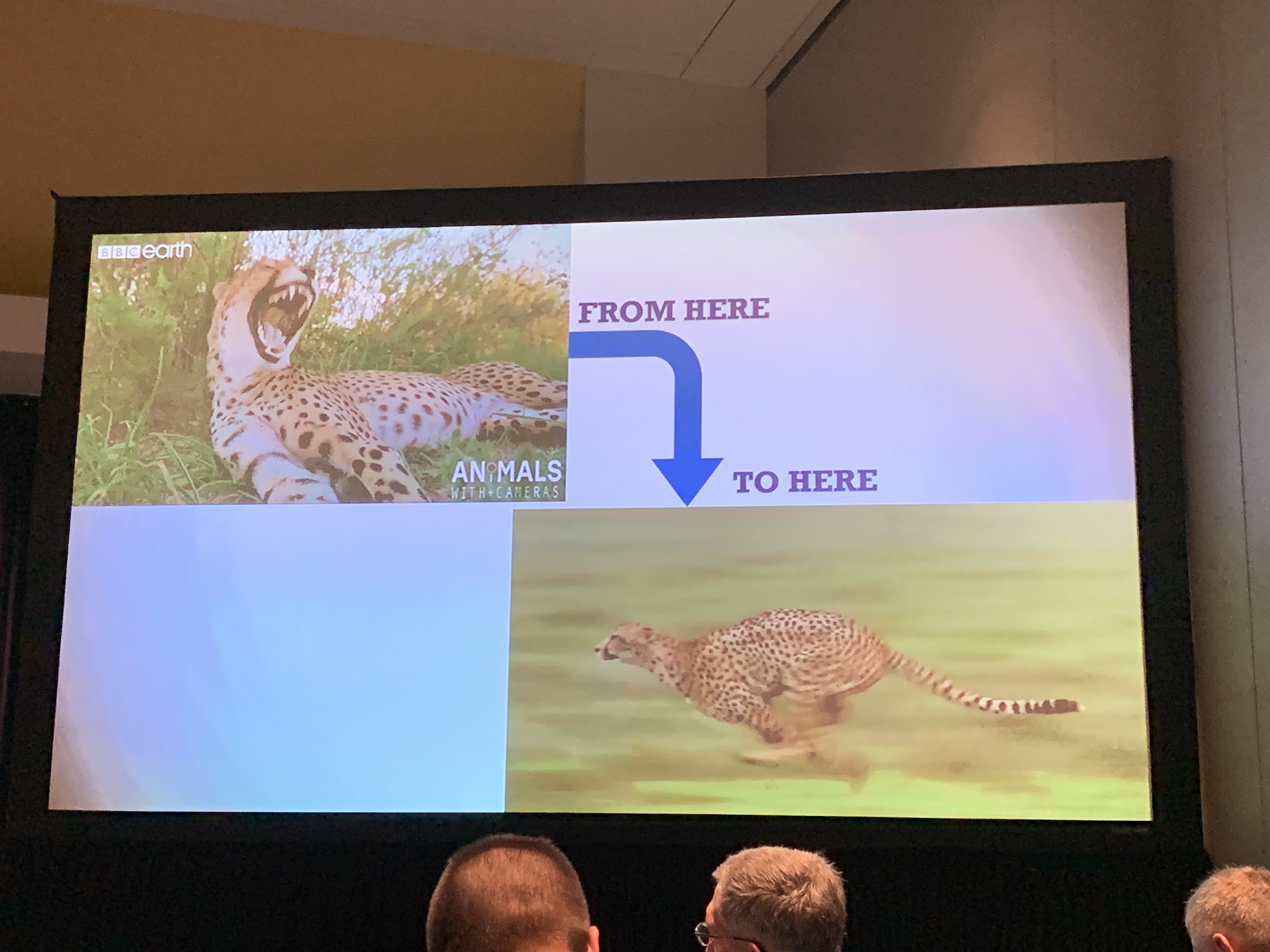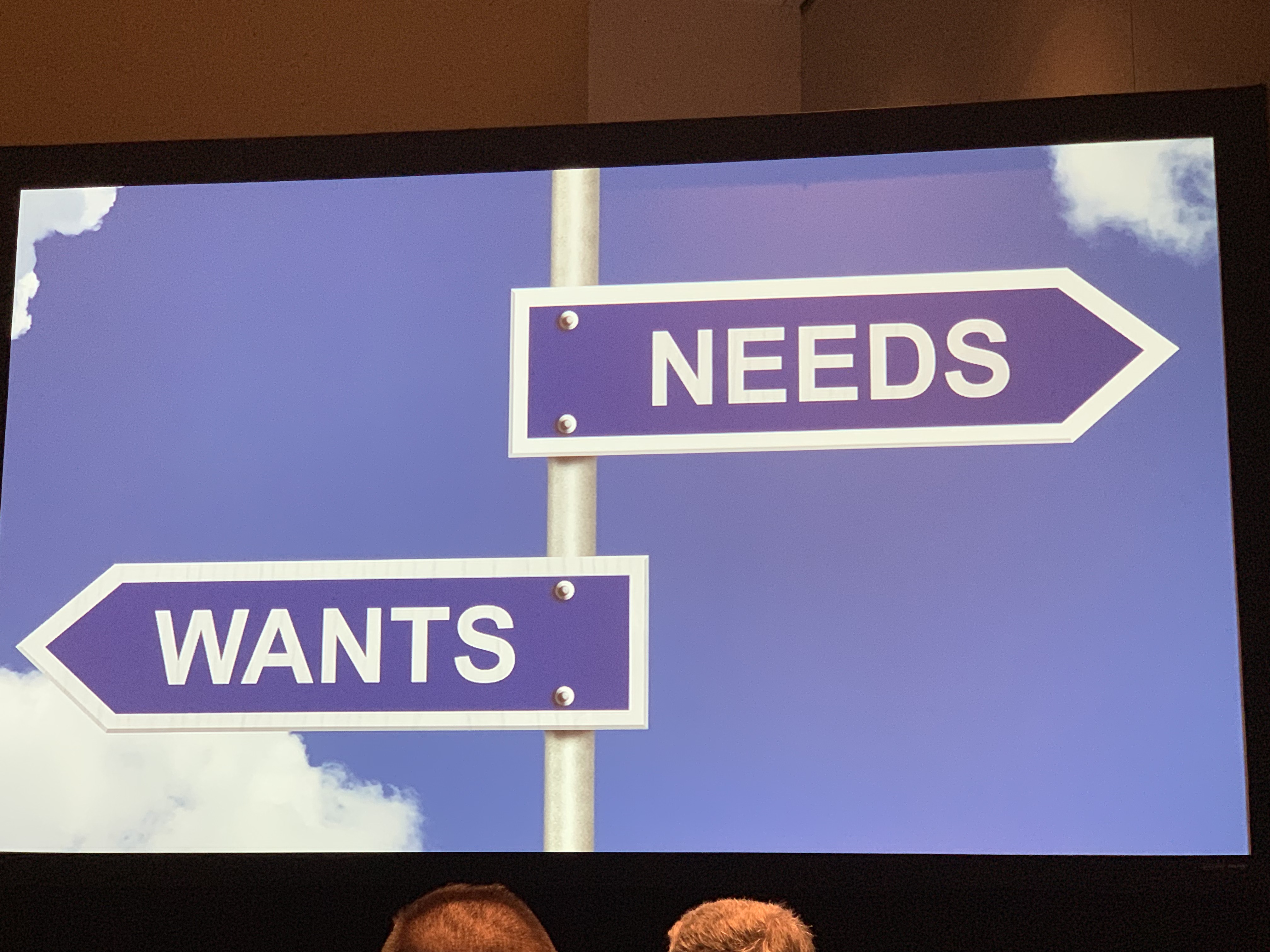- Created by Lara Anastasiou, last modified on Nov 11, 2019

EDUCAUSE is a nonprofit association whose mission is to advance higher education through the use of information technology.
EDUCAUSE Annual Conference 2019
October 14–17, 2019
McCormick Place West | Chicago, IL
https://events.educause.edu/annual-conference
Tracks
- Creating a Culture of Data-Informed Decision-Making
- Evolving Infrastructure and Enterprise IT
- Exploring New Boundaries in Teaching and Learning
- Leading and Partnering Across the Institution
- Making an Impact with Innovative Ideas
- Managing and Reducing Information Technology Risk
- Navigating Change
- Supporting the Institution
- Transforming the Student Experience
Notes and documentation
- Educause 2019_JPPispa.pdf
- Slides from the Educause Top 10 IT Issues for 2020: E19Session_Top10Issues.pdf
Key themes and findings from EDUCAUSE 2019

EDUCAUSE TOP 10 IT Issues
Information Security Strategy: Developing a risk-based security strategy that effectively detects, responds to, and prevents security threats and challenges
Privacy: Safeguarding institutional constituents' privacy rights and maintaining accountability for protecting all types of restricted data
Sustainable Funding: Developing funding models that can maintain quality and accommodate both new needs and the growing use of IT services in an era of increasing budget constraints
Digital Integrations: Ensuring system interoperability, scalability, and extensibility, as well as data integrity, security, standards, and governance, across multiple applications and platforms
Student Retention and Completion: Developing the capabilities and systems to incorporate artificial intelligence into student services to provide personalized, timely support (new!)
Student-Centric Higher Education: Creating a student-services ecosystem to support the entire student life cycle, from prospecting to enrollment, learning, job placement, alumni engagement, and continuing education
Improved Enrollment: Using technology, data, and analytics to develop an inclusive and financially sustainable enrollment strategy to serve more and new learners by personalizing recruitment, enrollment, and learning experiences (new!)
Higher Education Affordability: Aligning IT organizations‚ priorities, and resources with institutional priorities and resources to achieve a sustainable future
Administrative Simplification: Applying user-centered design, process improvement, and system reengineering to reduce redundant or unnecessary efforts and improve end- user experiences (new!)
The Integrative CIO: Repositioning or reinforcing the role of IT leadership as an integral strategic partner of institutional leadership in supporting institutional missions
TOP 10 IT Issues within the four themes
Simplify
4. Digital Intgegrations
9. Administrative Simplifications
- Need to do more with less
- Good experience to end users
- Break down the silos
- Not enough resources and funding → need different strategies to tackle the issues of 2020
Sustain
1. Information Security Strategy
2. Privacy
3. Sustainable Funding
8. Higher Education Affordability
- Information security as a top issue
- Security analytics
- Institutions need to recognise IT's value to business models
- Data is the new currency of the institutions
Innovate
5. Student Retention and Completion
6. Student-Centric Higher Education
7. Improved Enrollment
Drive to Dx (Digital transformation)
10. The Integrative CIO: Repositioning or reinforcing the role of IT leadership as an integral strategic partner of institutional leadership in supporting institutional missions
- Which changes first, the institution or the CIO?
- Digital transformation is not digitization
- Does this all hinge on the Integrative CIO? → CIO as a key to tackle the nine other issues


Digital transformation – towards learner centred higher education and "knowledge-era"
4th industrial revolution - Education 4.0 - what next?
- Big revolutions & changes, small resources
- HEI's have a strong will to change, but does not how to do it
- Traditionally HEI's do a lot alone and the work is siloed, digitalisation increases the need for cooperations and shared resources
- Change management as a critical aspect
- Being a small school with limited resources can also be an asset, a possibility to be more agile, have less bureaucracy, focus and build partnerships with not only other schools but also local vendors and other organisations.
- Why we will succeed this time? What should we do?
Student expect chance, society demands it and universities need it
- Educate students for the world of tomorrow, not today
- Start using new technologies: experiment, innovate, be agile
- Teach "human", not repeatable skills
Learner-driven revolution – reconceptualizing Education
- There is a clear need to define what does it mean to e a life-long learner
- On employer view it brings the demand to constantly look what are the next acts that employees are taking, how to up-skill and re-skills people.
- As 40-year careers are gone there is a need to imagine how to bring together corporations, individuals, public sector and universities to tackle the issue together
- A collaborative ecosystem will drive this transformation
- enable continuous learning
- investment in learning
- develop the knowledge and skills that deliver learning and employability outcomes that learners and employers seek
- Digital skills will be required in all disciplines: human & technology skills will be even more closely integrated in all professions; using data, large datasets and algorithms become more and more important
- Average employee will need 101 days retraining and up-skilling by 2020, still time for reselling is limited which poses a challenge for life-long learning.
- Frequent up-skilling and retraining does it that there will not be time to always go back to do a degree
- Micro-learning evolves
- A lot of retraining focuses to people that are already educated, now we have the challenge to reach and upskill low-literate workers and fit the lifestyle of time-constrained adults
- AI supporting the change and making possible to do thing differently.
Reimagining IT: A Study in IT Transformation, case Penn State University
- 99 000 students, 692 000 alumni
- Plan A: Reimagining IT - aligning resources, creating capacity for innovation
- Resistance points & mistakes:
- Figuring what is IT and what it meant, was really hard and throughout understanding was not completed in any unit
- Shared resources made some of the "best" schools to feel it was unfair
- IT directors, deans, chancellors & VP's concerned about status and autonomy and ability to be agile, people used running their own units in their own way
- Communication wanted to be made top-down and it slowed down the ability to communicate and created mistrust. Inability to communicate quickly, created a thought of lack of transparency.
- Resistance points & mistakes:
- Plan B: Reimagining reimagining IT
- Need to take a step Bach and think what to do better and how
- Huge budget cuts highlighted the need think again
- New plan: Service by service aproach
- service by service approach gives time to think through on where there is possibility to do cuts
- Putting units in control of their own budget cuts, can decide in where to cut
- Internal audits, making sure that the same practices are putting in place in all the schools in Penn State
- Challenges
- Lack of culture of governance
- Understanding university's decision making
- Need to change the decision making pace from "traditional university style" to quick, effective style → need to move fast
- IT operations and siloed, need to have more cooperation and collaborations. Need to think differently to be more effective and provide services to the university in more cost effective way
- Goal: Central IT budget that is sustainable
- Quick wins?
- different groups for IT directors, getting their feedback, developing the change with them
- partnerships
- transparency and honesty


Solutions to support digital transformation
Trusted Learner Network
- Approach to recording, curating & sharing learner data on abilities and skills across the learner's lifespan
- Open source technology, partnering with Salesforce
- Recording learner's achievements of ones whole lifetime, not only studies but also work experience, hobbies and other abilities
- Meta data of achievements, also examples on student work etc can be included
- Syllabus attached to all the records, what is the next step? Syllabus is not always the best way to describe skills
- No labels